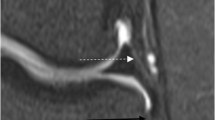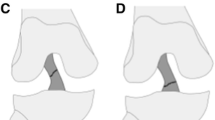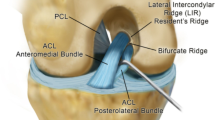Abstract
In 56 patients with anterior cruciate ligament (ACL) rupture, we retrospectively examined osseous lesions secondary to the rupture using magnetic resonance imaging (MRI). Depending on the time from their ligamentous injury to the performance of MRI, the patients were divided into three groups: the acute group (less than 1 month, n = 20), the subacute group (between 1 and 12 months, n = 16), and the chronic group (12 months or more, n = 20). Occult osseous lesions which were not detected by roentgenography were revealed by MRI in 14 patients in the acute group (70.0%), 5 in the subacute group (31.3%), and 1 in the chronic group (5%). The detection rate of osseous lesions by MRI was significantly higher in the acute group than in the other groups (P < 0.001). Osseous lesions were always detected in the same locations of the lateral compartment of the knee joint. When examined by arthroscopy, these lesions were often found to be accompanied by articular cartilage injuries. In the acute group, osseous lesions were visible in the high signal intensity area of T2-weighted images and in the low signal intensity area of proton density images. They were interpreted as representing hemorrhage and edema within the bone marrow. In the subacute and chronic groups, the osseous lesions were smaller, and their signal intensity on T2-weighted images was lower than that in the acute group, probably reflecting the ongoing resorption of the hemorrhage and healing of the lesions. These results suggest that osseous lesions develop following injury to the ACL.
Similar content being viewed by others
References
Galway HR, MacIntosh DR (1980) The lateral pivot shift: a symptom and sign of anterior cruciate ligament insufficiency. Clin Orthop 147:45–50
Mink JH, Deutsch AL (1989) Occult cartilage and bone injuries of the knee: detection, classification and assessment with MR imaging. Radiology 170:823–829
Noyes FR, Basset RW, Grood ES, Butler DL (1980) Arthroscopy in acute traumatic hemoarthrosis of the knee. J Bone Joint Surg [Am] 62:687–695
Rosen MA, Jackson DW, Berger PE (1991) Occult osseous lesions documented by magnetic resonance imaging associated with anterior cruciate ligament ruptures. Arthroscopy 7:45–51
Seebacher JR, Inglis AE, Marshall JL, Warren RF (1982) The structure of the posterolateral aspect of the knee. J Bone Joint Surg [Am] 64:536–541
SpeerKP, Spritzer CE, Bassett FH, Feagin JA Jr, Garrett WE Jr (1992) Osseous injury associated with acute tears of the anterior cruciate ligament. Am J Sports Med 20:382–389
Author information
Authors and Affiliations
Rights and permissions
About this article
Cite this article
Nawata, K., Teshima, R. & Suzuki, T. Osseous lesions associated with anterior cruciate ligament injuries. Arch Orthop Trauma Surg 113, 1–4 (1993). https://doi.org/10.1007/BF00440586
Received:
Issue Date:
DOI: https://doi.org/10.1007/BF00440586




